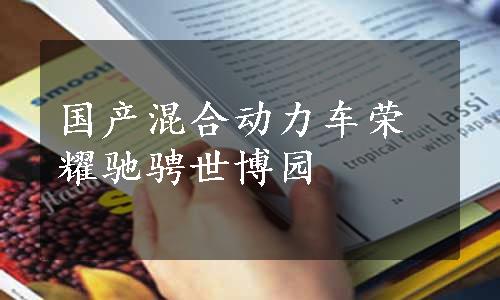
Shanghai World Expo Embracing Thousands of Vehicles
Shanghai World Expo——A Platform for New Energy Vehicles
2010年上海世博会期间共有196辆燃料电池汽车投入使用,包括90辆燃料电池轿车、6辆燃料电池公交客车和100辆燃料电池观光车,共有451辆纯电动车辆投入示范运行,其中包括120辆纯电动公交客车、61辆超级电容公交客车、140辆纯电动场馆车和130辆纯电动观光车,主要作为园区内地面公共交通工具和工作人员用车。所有车辆都应用了我国自主研发的技术成果,在动力性、经济性、续驶里程等方面位居国际先进水平行列。共应用混合动力汽车500辆,其中包括350辆混合动力轿车和150辆混合动力公交客车,主要作为“低排放”地面交通工具用于世博园区周边。
In 2010, Shanghai world Expo was equipped with 196 fuel cell vehicles including 90 fuel cell cars, 6 fuel cell buses and 100 fuel cell sightseeing vehicles. Besides, 451 battery electric vehicles were put into use for demonstration involving 120 electric buses, 61 super-capacitor electric buses, 140 electric buses for internal transportation of Expo and 130 electric sightseeing vehicles. Those vehicles are served as public transportation for visitors and also as staff transportation. All the vehicles were a display of China’s self-developed technical achievements, reaching international advanced level in terms of power performance, economical efficiency,driving range and so on. A total of 500 hybrid electric vehicles are in service as “low emission” transportation surrounding the Expo, consisting of 350 hybrid electric cars and 150 hybrid electric buses.
燃料电池汽车技术
Technology of Fuel Cell Vehicle (FCV)
燃料电池汽车采用电动机来获得动力,用燃料电池作为能源转换装置,其能源来自氢气。在众多的新能源汽车中,燃料电池汽车实现了对燃油的完全替代,并因为零排放、效率高、燃料来源广等优势而被认为是未来汽车工业可持续发展的方向,也是解决全球能源问题和气候变暖问题最理想的方案之一。燃料电池的效率随输出功率变化的特性比内燃机更适合于汽车的实际运行。
Powered by electric motors, FCVs conduct energy conversion in fuel cells whose energy comes from hydrogen. Among numerous NEVs, FCVs are completely fueled by electricity instead of fuel oil. Due to the advantages such as zero emissions, high efficiency and vast source of fuel, FCVs are regarded as one of the best solutions to problems like global energy and global warming. In the future, FCVs are seen to drive forward the sustainable development of auto industry. In fact, compared with internal combustion engines, fuel cells are more suitable for vehicles, due to its efficiency that varies with the output power.
2010年上海世博燃料电池汽车使用的氢气由上海焦化厂排放的焦炉气分离和提纯而成,实现了工业副产物氢气循环利用。提纯后氢气的纯度可达99.99%,产氢能力为400Nm3/h,可保证上海世博会期间燃料电池车辆每天约600公斤的用氢需求。
During Shanghai World Expo in 2000, the hydrogen for FCVs is extracted and purified from coke-oven gas emitted from shanghai coking plants, realizing the recycling use of hydrogen from industry by product. The hydrogen fined reaches a high purity of 99.99%. Hydrogen production capability is 400 Nm3/h, making sure to meet the demands of 600 kg hydrogen every day for FCVs during Shanghai World Expo.
为配套世博燃料电池汽车的示范运行,在燃料电池汽车行驶路线附近新建了1座世博加氢站和2辆移动加氢车,为50辆燃料电池轿车和6辆燃料电池公交客车、100辆燃料电池观光车提供燃料补给服务。同时通过对安亭加氢站进行适应性改造,为另外40辆燃料电池轿车提供燃料补给服务。
For better running of FCVs in Shanghai World Expo, a hydrogen refueling station and two refueling cars are newly built near the driving routes of FCVs, fueling 50 fuel cell cars, 6 fuel cell buses and 100 fuel cell sightseeing vehicles. At the same time, Anting Refueling Station undergoes adaptive renovation for fuel supply of another 40 fuel cell cars.
纯电动车技术
Technology of Battery Electric Vehicle (BEV)
纯电动车是完全由动力蓄电池提供电力驱动的电动车,具有零排放、不依赖汽油的特点,但由于蓄电池的能量密度和功率密度比汽油或柴油低很多,因此纯电动车的续驶里程有限,主要应用于小型、短途的社区交通。(www.xing528.com)
BEV is completely driven by electricity generated by storage battery, featuring zero emissions and independence from petrol. This kind of vehicle is mainly designed for short-term transportation due to its limited driving range because the energy density and power density of storage battery are much lower than those of petrol or diesel.
2010年上海世博会期间共有451辆纯电动车辆投入示范运行,其中包括120辆纯电动公交客车、61辆超级电容公交客车、140辆纯电动场馆车和130辆纯电动观光车,主要作为园区内地面公共交通工具和工作人员用车。所有车辆都应用了我国自主研发的技术成果,在动力性、经济性、续驶里程等方面位居国际先进水平行列。
During Shanghai World Expo in 2000, there were 451 battery electric vehicles running for demonstration involving 120 electric buses, 61 super-capacitor electric buses, 140 electric buses for internal transportation of Expo and 130 electric sightseeing vehicles. Those vehicles are served as ground public transportation and also as staff transportation. All the vehicles were a display of China’s self-developed technological achievements,reaching international advanced level in terms of power performance, economical efficiency, driving range and so on.
混合动力汽车技术
Technology of Hybrid Electric Vehicle (HEV)
混合动力汽车利用电机作为发动机的辅助动力驱动汽车,通过调节电机的转矩和转速等来控制发动机的工作状况,使发动机始终工作在相对稳定的工况中,从而改善行驶性能。在起步、加速时,由于有电动马达的辅助,可降低油耗,提高汽车的燃油经济性,从而减少废气排放。
Relying on the driving force given by the engine and assisted by the electric motor, HEVs control the work of engine by the adjustment of torque and rotating speed of the electric motor so as to improve the driving performance. Thanks to the assistant of electric motor, HEVs are able to reduce fuel consumption and decrease exhaust emission when they start or speed up.
混合动力汽车的种类目前主要有3种,即以发动机为主动力,电动马达作为辅助动力的“并联方式”;在低速时只靠电动马达驱动行驶,速度提高时发动机和电动马达相配合驱动的“串联、并联方式”;只用电动马达驱动电动汽车行驶的 “串联方式”,发动机只作为动力源,汽车只靠电动马达驱动行驶,驱动系统只是电动马达,但因为同样需要安装燃料发动机,所以也是混合动力汽车的一种。
Now, there are mainly three kinds of HEVs. First, main driving force is given by the engine while the electric motor offers auxiliary power. Second, electric motor is used for slow driving. However, engine and electric motor are combined to drive forward the vehicle when it accelerates. Third, electric motor is merely to generate driving force at start, while the vehicle relies on the engine after it is started. Since it is equipped with fuel engine, is can be seen as one kind of HEVs.
2010年上海世博会期间共应用混合动力汽车500辆,其中包括350辆混合动力轿车、150辆混合动力公交客车,主要作为“低排放”地面交通工具用于世博园区周边。自主研发的上海通用君越混合动力轿车采用皮带驱动起动发电机一体化(BSG)方案,自主研发的混合动力大巴动力系统包括国Ⅳ发动机-起动与发电(ISG)一体化集成和主驱动电机与减速箱一体化集成两种技术方案。世博会上应用的混合动力汽车在技术指标方面,依据不同混合度方案,节油率达到10%~40%;排放达到国Ⅳ标准以上;混合动力主要部件首次大修里程达到8万至10万公里,车辆安全性达到标准法规要求,具备产业化条件。
During Shanghai World Expo in 2000, a total of 500 hybrid electric vehicles are in service as “low emission”transportation surrounding the Expo, consisting of 350 hybrid electric cars and 150 hybrid electric buses. Selfdeveloped LaCrosse of SGM adopts the design of belt-driven starter generator (BSG), while self-developed hybrid electric buses comprise two technological proposes, namely Integrated Starter Generator (ISG) of engine(CHINA Ⅳ) and Integration of main electric motor and gearbox. HEVs in Shanghai World Expo saved 10%~40%fuel oil according their different mixing program. And their emissions are above the standards that CHINA Ⅳsets. When the main parts need overall repairing for the first time, HEVs have run up to 80 000~100 000 miles.Since HEVs meet safety requirements and standards, they can be industrialized.
目前汽车的节能必须双管齐下:通过技术升级和产品结构调整,大力发展小排量汽车和柴油发动机汽车,提高汽车的节能效果;长远来看,必须通过发展新能源与替代能源汽车,实现能源的可持续发展和绿色环保。可以说,与对新能源汽车技术重视程度相比,中国近几年并未对燃油动力系统进行较大开发投入,燃油发动机的节能减排技术远低于国际先进水平,平均油耗高于国外发动机10%以上。而从今后几十年中国汽车行业的情况来看,传统汽车仍将在相当长一段时间内占绝大多数比例,仍将主要依赖低成本的燃油发动机。
Recently, ambidextrous approach must be taken for energy conservation of cars. On one hand, by technology upgrading and product structure adjustment, small-displacement vehicles and cars with diesel engines shall enjoy rapid development for better energy saving. In the long run, NEVs and alternative energy vehicles shall be developed for sustainable development of energy and for going green and environmental development. In fact,compared with the attention paid to NEVs, China hasn’t put emphasis on fuel oil power system so far. Thus, the technology of energy-saving and emission reduction of oil engine lags far behind international advanced level and the average fuel consumption is over 10% higher than that of foreign countries. In light with China’s auto industry in the following decades, traditional vehicles will account for a large proportion in a long time, depending mainly on low-cost oil engines.
(上海汽车集团股份有限公司等单位供稿,祁凌云等整理)
(Contributed by SAIC Motor Co.,Ltd., sorted by Qi Lingyun)
免责声明:以上内容源自网络,版权归原作者所有,如有侵犯您的原创版权请告知,我们将尽快删除相关内容。




